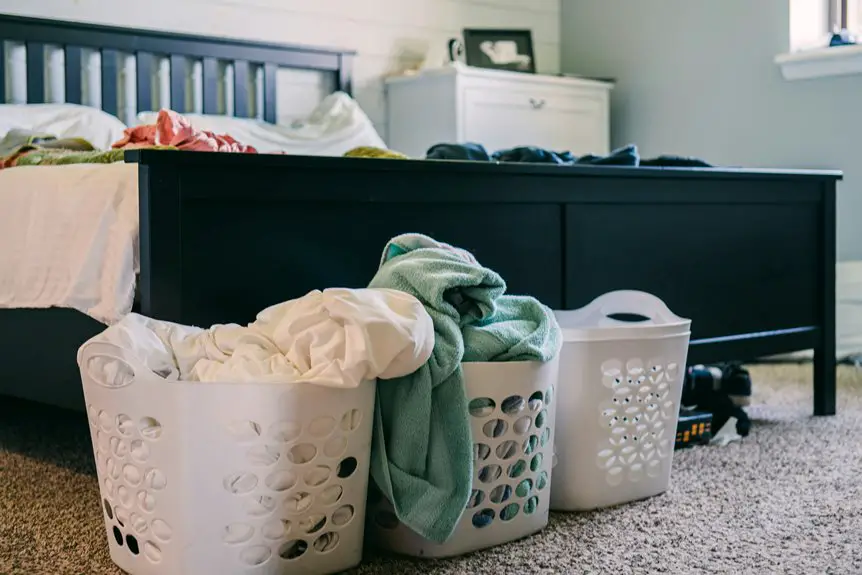Start decluttering your bedroom by making your bed and removing visible clutter from surfaces. Next, tackle your closet by sorting clothes into keep, donate, and trash piles, using matching hangers and drawer dividers to maximize space. Roll clothes instead of folding them to fit more items and prevent wrinkles. Clear your nightstand of unnecessary items, keeping only essentials within reach. Store seasonal items in vacuum-sealed bags, and use vertical storage solutions like floating shelves to free up floor space. For a truly organized sanctuary, let's explore proven strategies to maintain your clutter-free haven.
Start With Your Bed
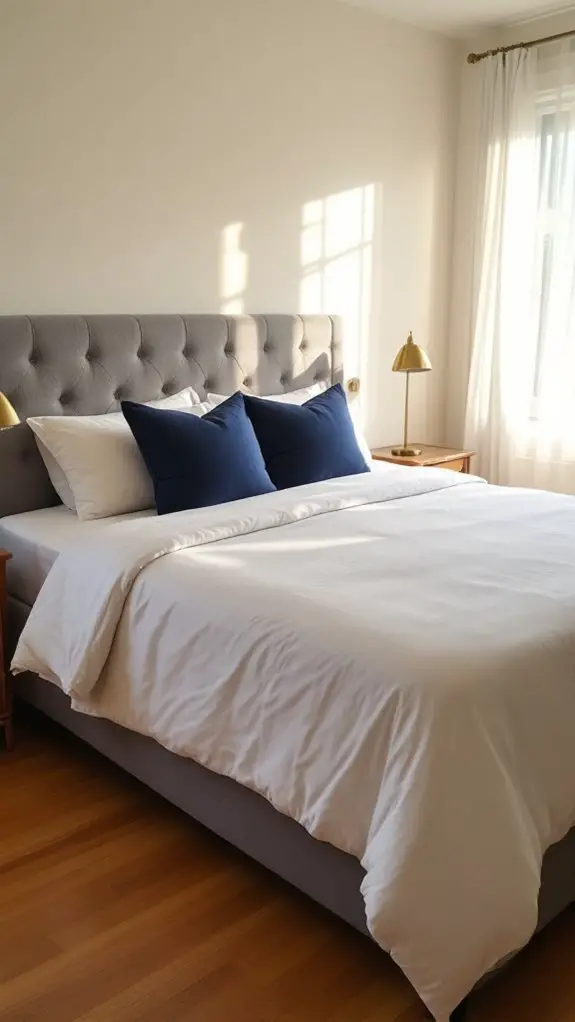
Everyone knows that making your bed sets the tone for a tidy bedroom. But beyond basic bed-making, you'll need to evaluate what's currently on and around your bed to create a clutter-free space.
Start by removing everything that doesn't belong there, including clothes, books, electronics, and random items that have accumulated over time.
Next, assess your bedding situation. Keep only the essentials: a fitted sheet, flat sheet, comforter or duvet, and your everyday pillows. Store seasonal bedding like extra blankets and decorative pillows in vacuum-sealed bags under your bed or in your closet. If you've got throw pillows, limit them to two or three for aesthetic purposes rather than collecting dozens that end up on the floor.
Take a look at your headboard area. If you're using it as a makeshift shelf, clear off items that create visual clutter.
Install a small floating shelf or bedside table instead to keep necessary items like your phone, a book, or a glass of water within reach. If you have a bed skirt, make sure it's clean and properly aligned to conceal any storage underneath.
Don't forget to check under your bed. This space can quickly become a catchall for forgotten items. Use flat storage containers with wheels for items you want to keep, and label them clearly.
Remove anything that's broken, unused, or doesn't belong in the bedroom. This will make cleaning easier and prevent dust buildup in hard-to-reach places.
Tackle the Closet Space
After organizing your bed area, your closet is the next major space that needs attention. Start by removing everything from your closet and sorting items into three distinct piles: keep, donate, and trash. Be ruthless in your decisions – if you haven't worn something in the past year, it's probably time to let it go.
Once you've sorted your items, install proper storage solutions that maximize your closet's potential. Add a second hanging rod if you have vertical space, and invest in matching hangers to create a uniform look. Use shelf dividers to prevent stacked clothes from toppling over, and install hooks on the closet walls for belts, scarves, and bags.
Group similar items together and organize them by category and color. Hang work clothes together, casual wear in another section, and formal attire separately. Store seasonal items in vacuum-sealed bags or boxes on high shelves or under the bed.
Don't forget to utilize the closet door – an over-the-door organizer can store shoes, accessories, or additional clothing items. Label storage containers clearly and maintain a system that works for your lifestyle. Keep frequently worn items at eye level and less-used pieces in harder-to-reach spaces.
Install proper lighting to help you see everything clearly, and consider adding cedar blocks or lavender sachets to keep clothes fresh. Remember to periodically reassess your closet's organization system and make adjustments as your needs change.
Sort Through Clothing
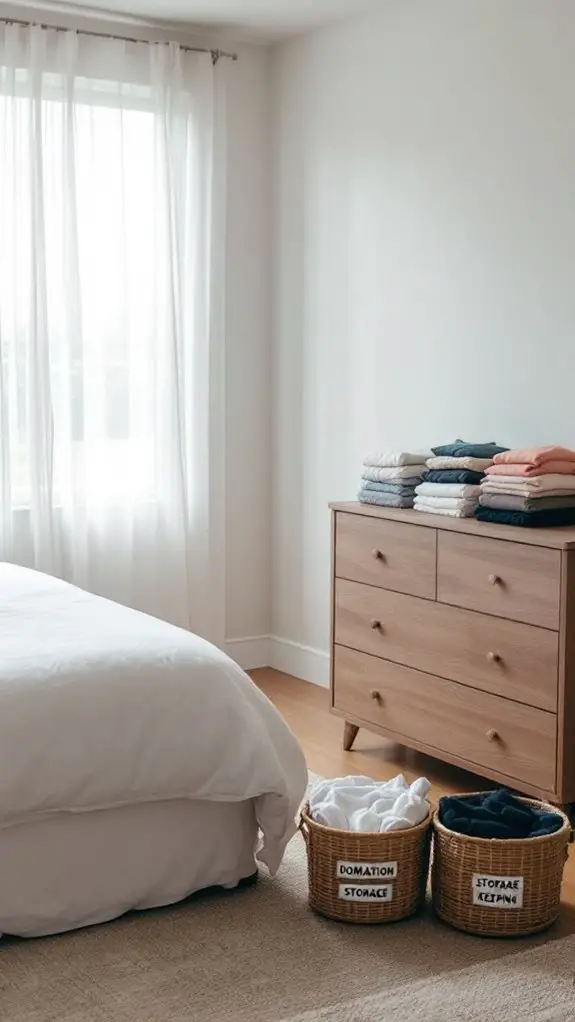
You'll make quick progress by separating your clothes into "keep" and "donate" piles while being honest about what you actually wear.
Take advantage of seasonal wardrobe rotation by storing off-season items in vacuum-sealed bags under your bed or in high shelves.
Your closet will feel more manageable when you're only looking at clothes you can wear right now, and you'll have a clearer picture of what you need versus what's just taking up space.
Seasonal Wardrobe Rotation
Managing your wardrobe through seasonal rotation is one of the most effective ways to declutter your bedroom. By dividing your clothes into seasonal categories and storing off-season items elsewhere, you'll free up valuable closet space and make your daily outfit selection easier.
Start by separating your clothes into winter, summer, and transitional pieces. Store heavy winter coats, sweaters, and boots in vacuum-sealed bags or plastic containers during summer months. Similarly, pack away sundresses, shorts, and sandals during winter. Keep transitional pieces like light jackets, jeans, and basic tees accessible year-round.
Label your storage containers clearly and include a detailed inventory list. This prevents you from buying duplicate items and helps you track what you own. Choose storage locations that are clean, dry, and temperature-controlled, such as under-bed spaces, top shelves, or basement storage areas.
Review your seasonal items before storing them. Check for damages, stains, or items you haven't worn. Clean everything thoroughly before packing it away, and consider donating pieces that no longer fit or suit your style.
This guarantees your seasonal rotation system remains efficient and clutter-free.
Keep Vs Donate Piles
Creating distinct keep and donate piles forms the backbone of any successful clothing organization project. Start by clearing a large space on your bed or floor, creating two designated areas for sorting. As you evaluate each piece, make quick, decisive choices to prevent second-guessing and maintain momentum.
For your "keep" pile, focus on items that fit well, make you feel confident, and you've worn in the last year. Consider each piece's condition, relevance to your current lifestyle, and how it coordinates with other items in your wardrobe. If you're unsure about an item, try it on immediately to make an informed decision.
Your "donate" pile should include clothes that no longer fit, show significant wear, or haven't been worn in over a year. Be honest about pieces that looked great in the store but never quite worked for you. Remove items that require repairs you're unlikely to make or that don't align with your current style.
Optimize Drawer Storage
Start with organizing your drawers based on how often you use items, placing frequently worn pieces in easy-reach spots.
You'll maximize space by rolling clothes instead of stacking them, which also prevents wrinkles and lets you see everything at a glance.
Install drawer dividers or use small boxes to create dedicated sections for different clothing types, making it simple to maintain order and find what you need quickly.
Sort By Usage Frequency
The most effective way to optimize drawer storage is to arrange items based on how often you use them. Place daily essentials like underwear, socks, and everyday clothing in the most accessible top drawers.
Reserve middle drawers for items you'll need weekly, such as workout clothes, casual wear, or seasonal accessories.
Store rarely used items like special occasion clothing, seasonal gear, or sentimental pieces in bottom drawers or hard-to-reach spaces. You'll want to group similar items together within each frequency category – for instance, keep all daily-wear t-shirts in one section and work clothes in another.
This system helps you quickly locate what you need while preventing less-used items from cluttering prime storage space.
Don't forget to reassess your usage patterns every few months. What you wear frequently might change with seasons or lifestyle shifts.
When you notice items that haven't been touched in months, consider donating them or moving them to long-term storage.
Keep drawer contents lean by maintaining a one-in-one-out rule: whenever you add a new item, remove something you rarely use.
Roll Instead of Stack
Once you've sorted your items by frequency, rolling your clothes instead of stacking them can transform your drawer space. This technique, popularized by organizing experts, allows you to see every item at a glance and maximizes vertical storage capacity. You'll fit up to 50% more clothing in each drawer while preventing wrinkles and creases.
Start by folding each garment into a rectangle, smoothing out any wrinkles. Then, tightly roll from one end to the other, ensuring the roll remains firm but not too tight.
Place these clothing rolls vertically in your drawers, standing them up like files in a filing cabinet. Arrange them by color or category for easy identification.
This method works particularly well for t-shirts, workout clothes, pajamas, and undergarments. For delicate fabrics or structured items like dress shirts, consider using soft drawer dividers to maintain the rolls' organization.
You can also apply this technique to scarves, belts, and even bedding. When you need something, simply pull out the specific roll without disturbing the others, maintaining your drawer's organization longer.
Create Drawer Divider Systems
Creating a functional drawer divider system elevates your storage capacity and maintains organization long-term. Start by measuring your drawer dimensions and identifying the specific items you'll store in each section. Purchase adjustable drawer dividers or create custom ones using materials like wood, acrylic, or sturdy cardboard.
Designate specific zones within each drawer based on item categories. Keep socks in one compartment, undergarments in another, and accessories separate. For deeper drawers, consider using stackable organizers to maximize vertical space.
Install tension rods or sliding dividers to create flexible sections that you can adjust as your storage needs change. Label each compartment clearly to maintain your system and prevent items from migrating to wrong sections. Use small boxes or fabric containers within the dividers to corral tiny items like jewelry, watches, or scarves.
Don't forget to leave some breathing room in each section to prevent overcrowding and make items easily accessible. Regularly assess your drawer organization and adjust dividers as needed to accommodate seasonal changes in clothing or new items you've acquired.
Clear Your Nightstand
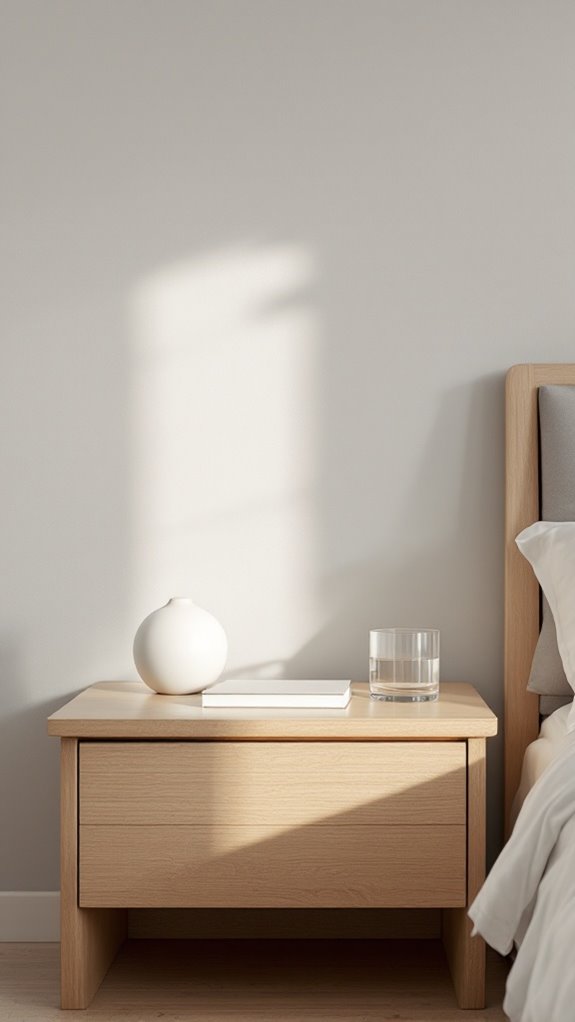
Your nightstand's cluttered surface can quickly become a magnet for daily items, turning a peaceful bedside space into a chaotic catch-all. To restore order and create a calming environment, you'll need to tackle this space with purpose and maintain strict boundaries about what belongs there.
Start by removing everything from your nightstand's surface and drawers. Sort items into three categories: essential, relocate, and discard. Keep only what you truly need within arm's reach while lying in bed, such as a lamp, your current book, reading glasses, and a small water glass. Consider mounting your bedside lamp to free up valuable surface space.
Install a drawer organizer to maintain order for smaller items you want to keep nearby. Use small containers or dividers to separate medications, charging cables, or personal items. If your nightstand lacks drawers, consider replacing it with one that offers storage, or add a small basket underneath for extra storage.
Create a nightly reset routine to prevent clutter from accumulating again. Before bed, return items to their proper homes, wipe down the surface, and arrange your essentials neatly. Don't let your nightstand become a dumping ground for loose change, receipts, or random objects that belong elsewhere.
If you need additional storage near your bed, consider alternative solutions like a narrow shelf unit or wall-mounted pocket organizer. These options can provide extra space without cluttering your nightstand's surface, helping maintain the serene atmosphere you've created.
Assess Wall Decor
Throughout the bedroom, wall decor can considerably impact the visual weight and perceived clutter of your space.
Take a critical look at your current wall arrangements and determine which pieces truly enhance your room's atmosphere versus those that create visual noise.
Start by removing everything from your walls and sorting items into three categories: must-keep, maybe, and donate/sell. For the must-keep pieces, select those that hold significant meaning or contribute to your desired aesthetic.
Consider limiting yourself to one focal point per wall to prevent overwhelming the space. If you've got multiple family photos, combine them into a single, well-organized gallery wall instead of scattered arrangements.
When reassessing your wall decor, focus on quality over quantity. Large, statement pieces often create less visual clutter than multiple smaller items.
If you're keeping mirrors, make sure they're strategically placed to reflect natural light and enhance the room's spaciousness. Remove any outdated or faded artwork that no longer serves your style preferences.
Don't forget to evaluate functional wall items like hooks, shelves, or bulletin boards. Keep only what you regularly use and make sure these items complement your room's organization system.
Consider replacing multiple small shelving units with one larger, more efficient piece. If you've got seasonal decor, create a rotation system rather than displaying everything at once.
Create Donation Piles
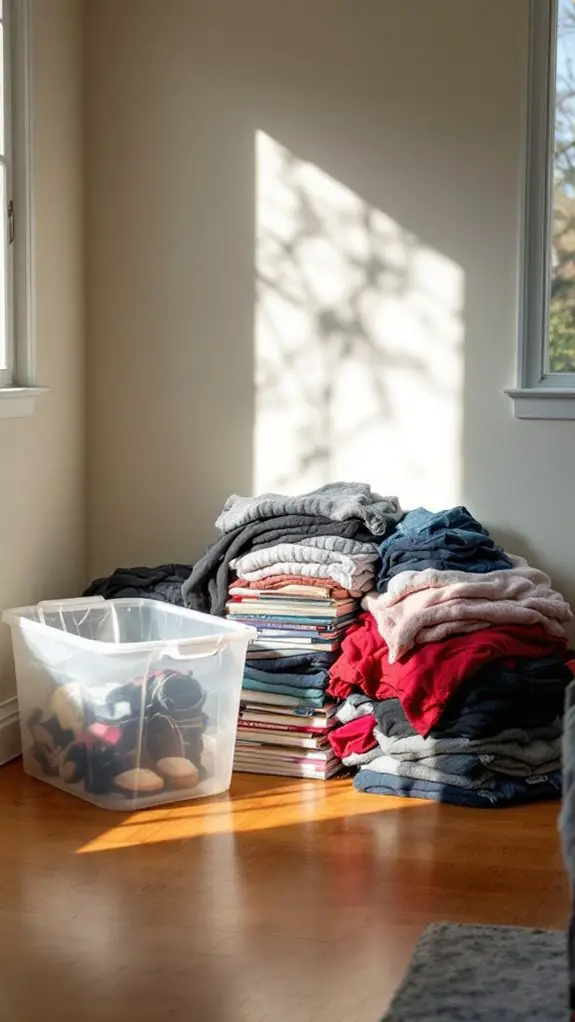
When you're ready to donate bedroom items, sort them right away into specific piles like clothing, books, and decor to prevent second-guessing your decisions.
You'll find the process more manageable by first offering usable items to local charities and organizations in your immediate community.
Consider reaching out to nearby shelters, religious organizations, or community centers before exploring other donation options, as they often have the most urgent needs and can put your items to immediate use.
Sort Items Immediately
Making decisions promptly about each item is essential for successful bedroom decluttering. When you handle an object, decide immediately whether to keep, donate, sell, or discard it. Don't create a "maybe" pile, as this only postpones decisions and creates additional work later.
Sort your items into clearly labeled boxes or bags as you go. Keep four containers nearby: one for items to keep, another for donations, a third for items to sell, and a fourth for trash. If you're keeping something, decide right away where it belongs and put it there.
For clothes, determine if you've worn them in the last year and if they still fit and match your current style.
Be honest with yourself about each item's value and usefulness in your life. If you haven't used something in months or it doesn't bring you joy, let it go. Don't hold onto things out of guilt or "just in case."
Remember that quick, decisive sorting prevents items from migrating back to their original spots and maintains your decluttering momentum.
Give Locally First
Instead of tossing unwanted items in the trash, prioritize local giving to benefit your community. Start by creating three distinct donation piles: clothing, furniture, and miscellaneous items.
Research local organizations that accept specific donations, such as women's shelters, homeless centers, or youth programs that might need your gently used items. Contact nearby churches, schools, and community centers to inquire about their current needs. Many of these organizations will arrange pickup services for larger items like dressers or chairs.
Don't forget to check if your local library accepts book donations or if animal shelters need old blankets and towels.
For clothing donations, make certain items are clean, folded, and sorted by season. You'll find that many local thrift stores prefer receiving seasonal items they can sell immediately.
Consider posting higher-value items on neighborhood apps or community boards where locals can pick them up directly. Remember to document your donations for tax purposes, and always call ahead to verify an organization's acceptance policies and drop-off hours.
This approach guarantees your unwanted bedroom items find new homes while supporting those in need nearby.
Maximize Vertical Storage
Since bedrooms often have limited floor space, maximizing vertical storage can dramatically increase your room's storage capacity while maintaining a clutter-free environment.
Start by installing floating shelves on your walls, which provide ample storage without taking up valuable floor space. You'll find these particularly useful for displaying books, photos, and decorative items that might otherwise clutter your surfaces.
Consider using over-the-door organizers for shoes, accessories, or clothing items. These handy solutions turn unused door space into functional storage areas.
Install hooks on the back of your bedroom and closet doors to hang robes, bags, or tomorrow's outfit. You can also mount pegboards on your walls to create customizable storage solutions for jewelry, accessories, or small items.
Make use of the vertical space in your closet by adding a second hanging rod or installing a closet organization system with multiple levels.
Use slim, vertical dressers instead of wide ones to maximize floor space while still providing plenty of drawer storage. Don't forget about the space under hanging clothes – add shoe racks or storage boxes to utilize this often-overlooked area.
Look up toward your ceiling for additional storage opportunities. Install ceiling-mounted storage racks in closets or corner spaces, or use high wall-mounted cabinets for seasonal items and less-frequently used belongings.
If you have high ceilings, consider adding a loft bed with storage or desk space underneath to really maximize your vertical space potential.
Establish Daily Cleaning Habits
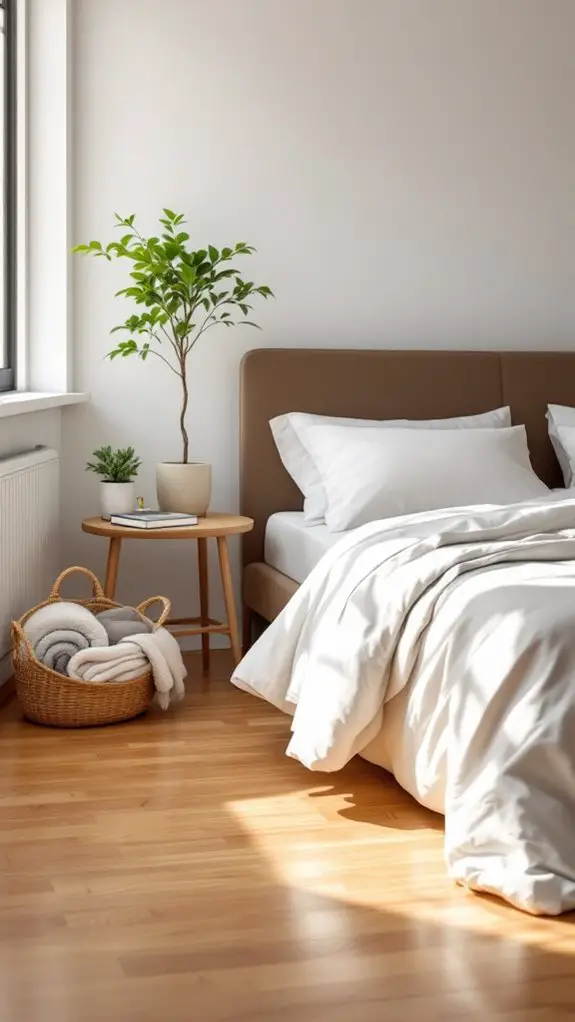
Developing consistent daily cleaning habits is the key to maintaining a clutter-free bedroom. By dedicating just 10-15 minutes each day to tidying up, you'll prevent clutter from accumulating and maintain an organized space that promotes relaxation and better sleep.
Start each morning by making your bed immediately after waking up. This simple task sets a productive tone for the day and instantly makes your room look neater. Before leaving for work or starting your day, put away any clothes from the previous day – either in the laundry basket or back in your closet. Don't let them pile up on chairs or the floor.
Throughout the day, follow the "one-touch rule" – handle items only once by putting them away immediately instead of setting them down temporarily. When you remove accessories or change clothes, place them directly in their designated spots.
Before bedtime, spend five minutes returning any misplaced items to their proper locations and clearing your nightstand of unnecessary items.
Implement the "in and out" principle – whenever you bring something new into your bedroom, remove something old. This prevents accumulation and maintains balance in your space.
Keep a small waste bin in your room for immediate disposal of trash, and empty it regularly. Additionally, maintain a donation box in your closet for items you no longer need, and when it's full, donate the contents immediately.
These daily habits will help you maintain an organized bedroom without requiring extensive cleanup sessions or major decluttering projects in the future.
Remove Unused Furniture
While daily cleaning habits keep your space tidy, unnecessary furniture can sabotage your decluttering efforts. Extra pieces not only take up valuable floor space but also collect dust and create additional surfaces where clutter accumulates.
Take a critical look at your bedroom furniture and identify items that don't serve a clear purpose. Start by evaluating each piece of furniture against three criteria: functionality, necessity, and frequency of use. That decorative bench at the foot of your bed might look nice, but if it's just collecting laundry, it's time to let it go.
Remove redundant items like extra nightstands, unused chairs, or small tables that have become drop zones for miscellaneous items. Consider removing bulky furniture that's out of proportion with your room size. If you've got a small bedroom, swap out that oversized dresser for a more compact version or replace it with closet organizers.
Don't keep furniture just because it's expensive or was a gift – if it's not serving your current needs, it's taking up precious space. Make smart choices about replacement pieces. If you need to keep some items, opt for furniture with built-in storage solutions.
A bed frame with drawers underneath can eliminate the need for an extra dresser, while a slim console table with compartments can replace that chunky vanity. Remember, every piece of furniture should earn its place in your bedroom by contributing to both function and organization.
Organize Storage Containers
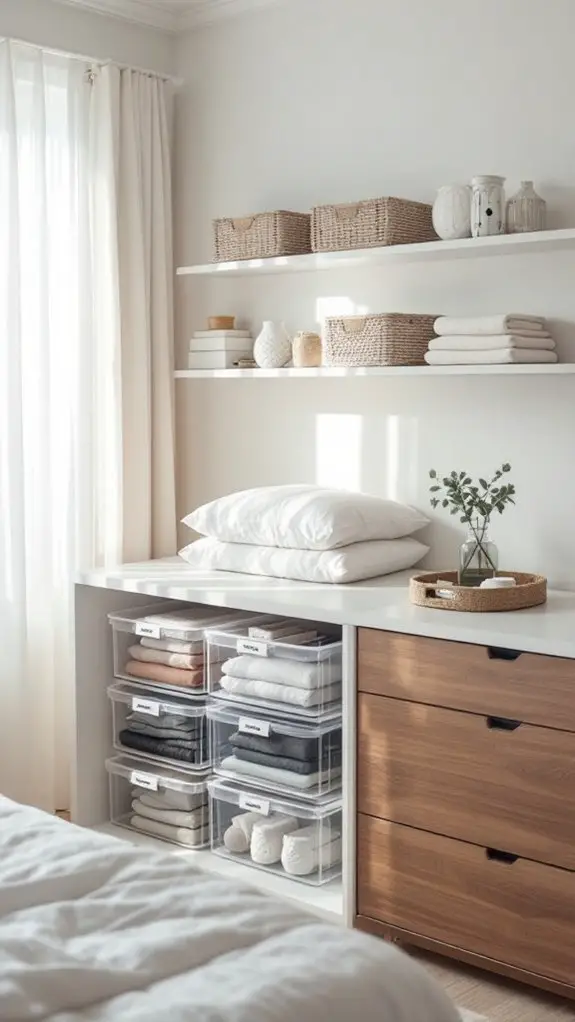
Inside a decluttered bedroom, storage containers play an essential role in maintaining order and maximizing space. You'll need to organize these containers systematically to guarantee they serve their purpose effectively while maintaining the room's peaceful atmosphere.
Start by categorizing your storage containers by size and function. Place large bins and boxes under the bed or in closet corners, using them for seasonal items like winter clothing or extra bedding.
Medium-sized containers work well on shelves or in closets, perfect for storing accessories, shoes, or folded clothing. Keep small containers on your dresser or nightstand for daily essentials.
Label each container clearly with its contents using a consistent system. You can opt for printed labels, handwritten tags, or clear containers that display their contents.
Group similar items together, such as placing all your jewelry boxes in one area or keeping gift-wrapping supplies in a designated bin.
Consider using stackable containers to maximize vertical space. Choose containers with secure lids to protect items from dust and make them easily accessible when needed.
For frequently used items, select containers with front-opening panels rather than those requiring you to unstack everything to reach the bottom.
Regularly assess your storage containers' effectiveness. If you find yourself struggling to locate items or if containers are overflowing, it's time to reorganize.
Remove any empty containers taking up valuable space, and replace damaged ones to maintain an efficient storage system.
Store Seasonal Items
Throughout the changing seasons, your bedroom needs dedicated spaces for items you won't use for months at a time.
You'll need to rotate clothing, bedding, and accessories based on weather conditions, making smart storage solutions essential for maintaining a clutter-free space.
Store your winter items during summer months in vacuum-sealed bags to maximize space and protect materials from dust and moths.
Pack away heavy blankets, wool sweaters, and winter coats in these compressed bags, then place them in clear storage containers labeled by category.
You can stack these under your bed or in the top of your closet.
For summer items during winter, roll beach towels, swimwear, and light clothing to save space.
Use cedar blocks or lavender sachets to keep stored clothing fresh and pest-free.
Consider using hanging garment bags for delicate summer dresses or suits that shouldn't be compressed.
Create a rotation schedule for your seasonal switches, typically in spring and fall.
Keep a detailed inventory list taped inside your storage containers, so you'll know exactly what's packed away.
Don't forget to store season-specific accessories like scarves, gloves, and sun hats in smaller boxes within your larger storage containers.
If you're tight on space, investigate off-site storage options for items you'll only use once a year.
Alternatively, install high shelving units specifically for seasonal storage, keeping these items accessible but out of your daily living space.
Remember to clean all items thoroughly before storage to prevent stains or odors from setting in.
Arrange Books and Reading Materials
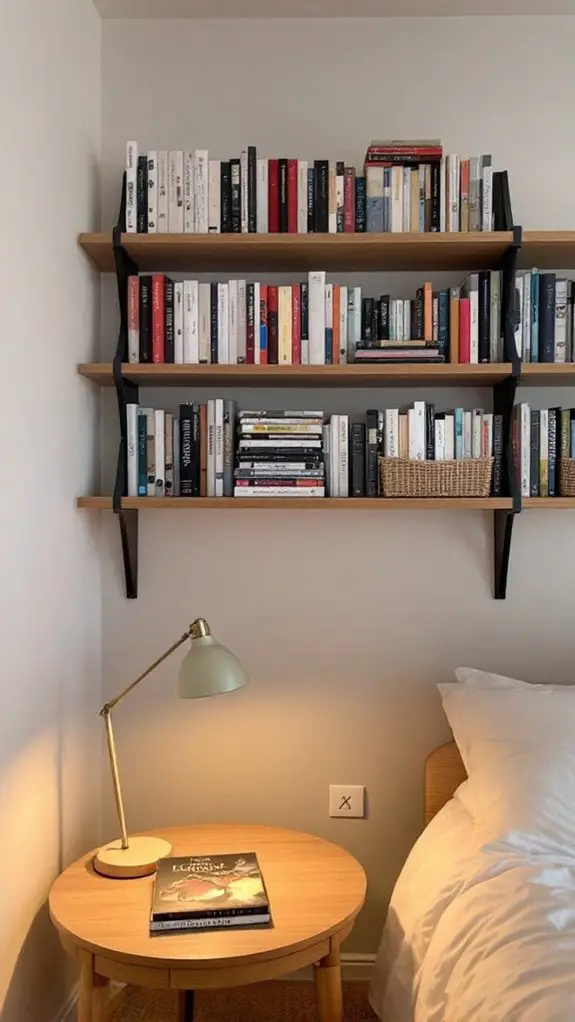
Books and magazines can quickly overwhelm your bedroom space if you don't have a proper organization system in place. To maintain a clutter-free environment, start by sorting your reading materials into three categories: keep, donate, and recycle.
Keep only the books you'll read again or hold sentimental value, and consider digitizing magazines after you've read them.
Install floating shelves or a compact bookcase to maximize vertical space while minimizing floor clutter. Arrange your books by height, color, or genre to create an organized and visually appealing display. Use bookends to uphold volumes upright and prevent them from falling over.
For frequently read books, place them at eye level for easy access. Store current magazines in a decorative magazine holder or wall-mounted rack. You'll want to limit yourself to keeping only the latest three issues of each subscription.
For bedside reading, select a few current books or magazines and store them in your nightstand drawer or a small basket nearby.
Consider implementing the "one in, one out" rule for your reading materials. When you acquire a new book or magazine, remove an old one to maintain your organized system.
If you're an avid reader, you might want to invest in an e-reader to reduce physical book storage needs. Don't forget to regularly dust your book collection and guarantee proper ventilation to prevent moisture damage and maintain good air quality in your bedroom.
Clear Floor Space
Keep your bedroom floor clear by removing unnecessary items like unused exercise equipment, old storage boxes, or laundry baskets that don't serve an immediate purpose.
You'll create a more spacious feel and reduce tripping hazards by installing wall-mounted shelves or using under-bed storage containers for items you need to keep.
Consider adding multi-functional furniture pieces, such as ottomans with hidden storage or bedside tables with drawers, to maximize floor space while maintaining easy access to essential items.
Remove Unnecessary Items
A clutter-free floor is essential for creating a peaceful bedroom atmosphere. To maintain this serenity, you'll need to systematically remove items that don't belong in your bedroom.
Start by identifying objects that serve no practical purpose or haven't been used in the past six months. Remove exercise equipment that's collecting dust and relocate it to a dedicated workout space. Take out boxes, storage containers, and miscellaneous items that you've been meaning to sort through.
Don't let your bedroom become a temporary storage area for items that belong elsewhere in your home. Remove excess furniture pieces that crowd the space, such as extra chairs or tables that aren't regularly used.
Evaluate your wardrobe and remove clothing that you no longer wear. Store seasonal items in vacuum-sealed bags under your bed or in another room.
Remove old magazines, books you've already read, and decorative items that create visual clutter. Consider donating these items or relocating them to more appropriate spaces in your home.
Smart Storage Solutions
Implementing smart storage solutions is essential for maintaining clear floor space in your bedroom.
Start by utilizing vertical space with tall, narrow bookcases or wall-mounted shelves that maximize storage without consuming valuable floor area. Install floating shelves above your desk or bed to display items while keeping them off the ground.
Make use of under-bed storage with rolling drawers or vacuum-sealed bags for seasonal clothing and extra bedding. If you don't have a bed with built-in storage, add bed risers to create additional space underneath.
Consider installing a closet organization system with multiple rods, shelves, and drawers to optimize your wardrobe storage.
Invest in furniture that serves multiple purposes, like an ottoman with hidden storage or a bedside table with drawers.
Mount hooks behind your door for robes, bags, and accessories. Use drawer organizers and small containers to keep items neatly separated and easily accessible.
If space allows, add a slim wardrobe or armoire against a wall rather than bulky dressers that extend into the room.
These solutions will help maintain an organized, spacious bedroom while maximizing your storage capacity.
Maintain Paper Organization
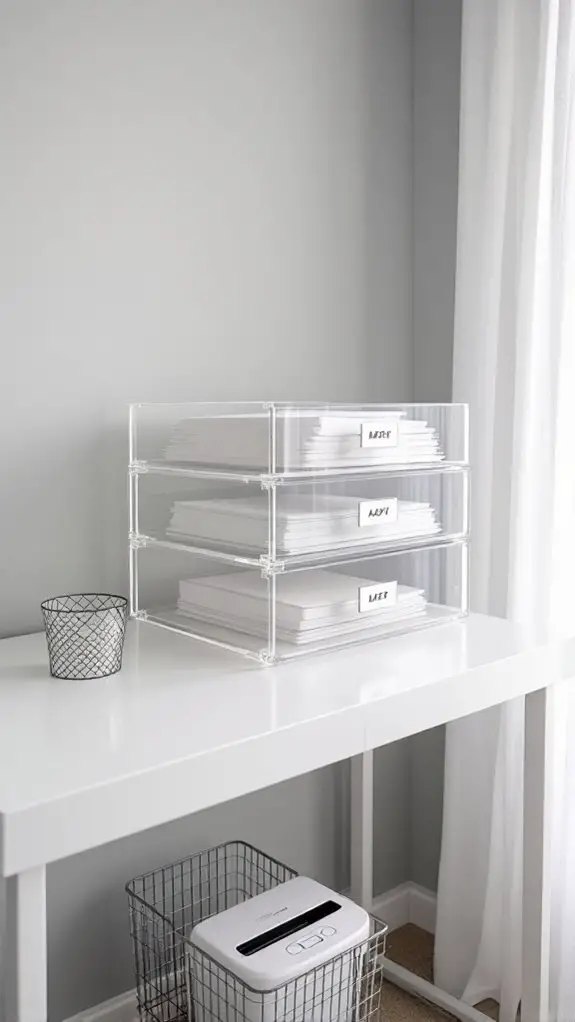
Orderliness starts with managing the paper clutter in your bedroom. You'll need a systematic approach to handle incoming mail, documents, receipts, and other paper items that tend to accumulate on your surfaces.
Start by creating three essential sorting bins: one for immediate action items, another for documents to file, and a third for items to shred or recycle.
Set up a compact filing system using a small file box or drawer organizer that fits your bedroom's space. Use clearly labeled folders to categorize important papers like bills, warranties, medical records, and tax documents.
Don't forget to include a designated spot for incoming mail that requires attention within the week.
Install a bulletin board or magnetic strip on your wall for temporary items like invitations, event tickets, or reminders. This keeps these papers visible without cluttering your surfaces.
Create a habit of immediately recycling junk mail and promotional materials you don't need.
Digitize documents whenever possible using your smartphone or a scanner. Store digital copies in cloud storage for easy access and backup. Keep only the physical copies of legally required documents and shred the rest.
Make it a weekly routine to process all paper items using your sorting system.
Consider adding a small shredder in your bedroom for sensitive documents, and place a recycling bin nearby for immediate disposal of unnecessary papers.
Remember to review your filed documents every six months to eliminate outdated materials and maintain an organized paper management system.

Erzsebet Frey (Eli Frey) is an ecologist and online entrepreneur with a Master of Science in Ecology from the University of Belgrade. Originally from Serbia, she has lived in Sri Lanka since 2017. Eli has worked internationally in countries like Oman, Brazil, Germany, and Sri Lanka. In 2018, she expanded into SEO and blogging, completing courses from UC Davis and Edinburgh. Eli has founded multiple websites focused on biology, ecology, environmental science, sustainable and simple living, and outdoor activities. She enjoys creating nature and simple living videos on YouTube and participates in speleology, diving, and hiking.

